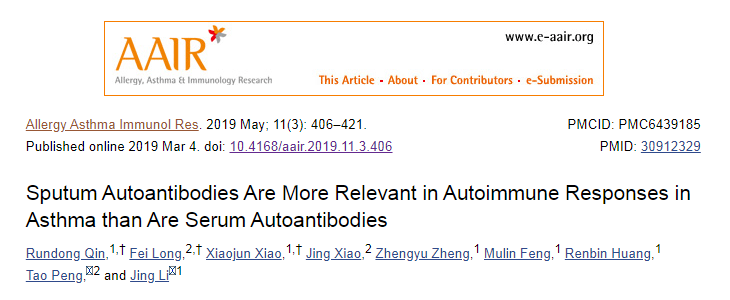
Allergy Asthma Immunol Res., 2019 May 11, ,DOI:10.4168/aair.2019.11.3.406
Sputum Autoantibodies Are More Relevant in Autoimmune Responses in Asthma than Are Serum Autoantibodies
Rundong Qin, Fei Long, Xiaojun Xiao, Jing Xiao, Zhengyu Zheng, Mulin Feng, Renbin Huang, Tao Peng, Jing Li
1 Department of Allergy and Clinical Immunology, State Key Laboratory of Respiratory Disease, The First Affiliated Hospital of Guangzhou Medical University, Guangzhou, China
2 State Key Laboratory of Respiratory Disease, Sino-French Hoffmann Institute, School of Basic Medical Science, Guangzhou Medical University, Guangzhou, China
Abstract
Purpose: The data on the differences between sputum autoantibodies (Sp-Abs) and serum autoantibodies (Se-Abs) in reflection of autoimmune responses to lungs is still lacking.
Methods: Ten types of Abs were investigated in matched Se and Sp samples collected from recruited subjects. Correlations between Ab levels and airway inflammatory parameters and measures of pulmonary function were assessed. The network-based and inter-correlated analysis was performed to explore the patterns of Sp- and Se-Ab profiles.
Results: Fifty stable asthmatic patients and 24 healthy volunteers were recruited for our study, 15 with mild asthma, 18 with moderate asthma and 17 with severe asthma. The concentrations of Sp-Ab against U1 small nuclear ribonucleoprotein (Sp-anti-U1-SnRNP), Sp-Ab against Smith antigen and Se-Ab against thyroid peroxidase (anti-TPO) in severe asthmatics and Sp-anti-U1-SnRNP in moderate asthmatics were significantly higher compared to healthy controls and mild asthmatic subjects (P < 0.05). Sp-anti-U1-SnRNP levels were positively correlated with the dose of inhaled corticosteroids, Sp eosinophil counts and fractional exhaled nitric oxide (r = 0.326, P = 0.022; r = 0.356, P = 0.012; r = 0.241, P = 0.025, respectively) and negatively correlated with Sp neutrophil counts (r = −0.308, P = 0.031) with adjustment for age. Spearman's correlation matrix showed multiple intercorrelations among Sp-Abs and Se-Abs (P < 0.05) while only the levels of Ab against DNA topoisomerase and anti-TPO in Se were correlated with those Sp-Ab counterparts (P < 0.05). The network-based analysis defined 2 clusters: clusters 1 and 2 contained 10 Sp-Abs and 10 Se-Abs, respectively.
Conclusions: This study observes that Sp-Abs are more associated with clinical parameters and the severity of disease in asthma compared to Se-Abs. Targeting on Sp-Abs which are the hallmark of the localized autoimmune event might help us better understand the role of autoimmunity in the pathological mechanism of asthma.
文章链接:10.4168/aair.2019.11.3.406